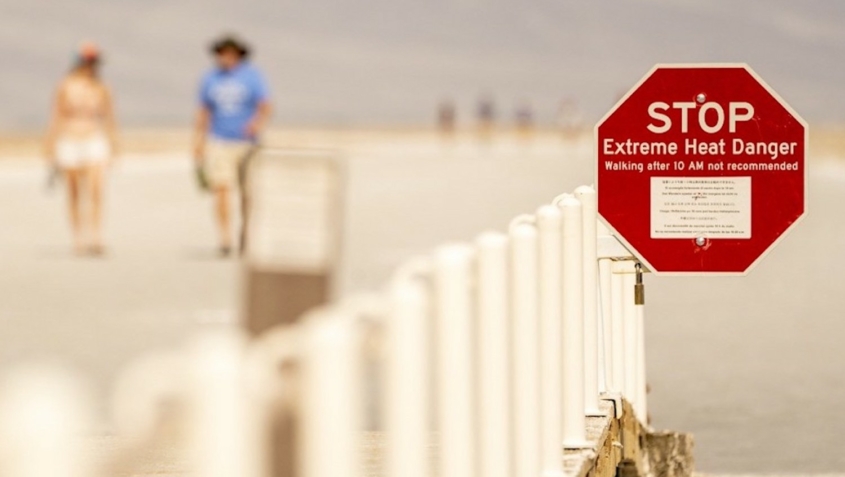
State Can Do More to Protect Californians From Extreme Heat, Report Finds Top environmental policy experts say a comprehensive approach is needed to deal with state’s deadliest global-warming side effect
A comprehensive statewide approach would better protect Californians from the Golden State’s deadliest climate change side effect: extreme heat. That’s according to “Adapting to Extreme Heat in California: Assessing Gaps in State-Level Policies and Funding Opportunities,” a new study by the UCLA Luskin Center for Innovation.
“We analyzed California’s current patchwork quilt of regulations and funding sources that have developed in various agencies of the state government. We found that when it comes to protecting people and communities from the risks of extreme heat, there are a lot of policy gaps, and many risks that could be mitigated have slipped between the cracks,” said JR DeShazo, the study’s co-author and founding director of the UCLA Luskin Center for Innovation who recently joined the University of Texas at Austin as dean of the LBJ School of Public Affairs.
The authors note that California is planning to spend $800 million over the next two years to address extreme heat and is also developing a framework for heat preparedness. The scholars hope the report can help Sacramento identify and fill gaps in the state’s heat-protective strategies.
California’s average temperatures are rising because of climate change. This summer was the hottest in state history, and Californians can expect more frequent and severe heat waves in the coming decades.
Death certificates show that heat exposure caused 599 deaths in California between 2010 and 2019, while a recent Los Angeles Times investigation analyzed the number of excess deaths during periods of extreme heat, and put that number at about 3,900. In addition to damaging physical and mental health, extreme heat makes it harder for students to learn, and harder for workers to do their jobs safely and maximize their earning potential. Extreme heat also forces families to pay more to cool their homes; especially for low-income Californians, this makes electricity shutoffs more likely.
“Adapting to Extreme Heat in California” details existing policies and programs addressing extreme heat exposure in seven “priority settings” — places where exposure to heat can be especially consequential.
“For example, our report assesses policies connected to extreme heat exposure at home and at workplaces, because that’s where most people spend most of their time. And because kids and elderly adults are especially vulnerable to heat-induced health impacts, we looked at schools, child-care facilities and assisted living facilities for seniors,” said Gregory Pierce, co-director of the UCLA Luskin Center for Innovation. Other priority settings analyzed in the report include transit stops, public outdoor spaces, prisons and other correctional facilities.
The report’s authors point out that there is no centrally responsible state authority to provide technical assistance, strategic funding or coordination to sister agencies to address the issue of heat, and that is a problem.
“We probably don’t want to put all statutory authority for heat risk regulation and resiliency into the hands of one agency — we’re not envisioning Homeland Security for heat. But Californians would benefit from a single authority that plays a robust coordinating and supporting role,” DeShazo said.
The researchers note that a central heat authority could conduct, commission and share research; coordinate development of statewide heat-risk-reduction policies; organize interagency cooperative efforts; promote public education; and fill in funding gaps.
The report’s other key findings include the following:
- Most existing California heat-exposure standards are inadequate, or have limited compliance. And for some priority settings, there are no standards at all. For example, there are no rules about keeping kids in school or people at home safe from extreme heat. And while building codes require all residences to be equipped to keep occupants warm, there is no equivalent rule requiring that they keep residents sufficiently cool.
- Most existing state programs do not make investments that explicitly target heat-vulnerable places or quantify heat risk-reduction benefits. The report’s authors reviewed over 20 programs overseen by 10 different state agencies that fund heat-relevant measures, such as the Urban Greening Program and the Low-Income Weatherization Program. None have heat-risk reduction as their primary objective.
- Local planning efforts may not prepare cities adequately for extreme heat. For example, state laws (SB 379, SB 1035) require local governments to update their general plans to address climate adaptation and resiliency by 2022. But implementing effective heat-reduction strategies will require additional investments for training, staff capacity and funding.
- Improving thermal comfort in public spaces and reducing urban heat island effects rely largely on voluntary state guidance. For example, California Building Energy Efficiency Standards require cool roofing materials, but only for newly constructed buildings, retrofits or building additions. And the CalGreenCode includes measures to reduce the urban heat island effect that results in city temperatures being higher than rural temperatures, but these measures are voluntary and lack readily accessible state financing assistance.
A growing body of research finds low-income communities and communities of color are disproportionately affected by extreme heat, due to structural discrimination and social inequities.
“Historically neglected communities have endured more than their fair share of harm from extreme heat and other effects of climate change, and must be front and center as California works on protecting its people as the world continues to warm,” Pierce said. “As the state considers a framework for heat preparedness and community resilience, equity must be a guiding principle.”



Leave a Reply
Want to join the discussion?Feel free to contribute!